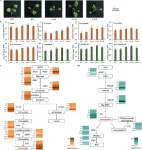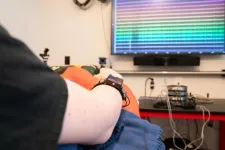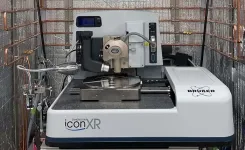(Press-News.org) FAIRFAX, Va. (July 9, 2024)— Among women who have personally been diagnosed with uterine fibroids, more than half (53%) were presented with a hysterectomy, while fewer than 1 in 5 (20%) were presented with other less invasive options such as over-the-counter NSAIDs (19%), uterine fibroid embolization (17%), oral contraceptives (17%), and endometrial ablation (17%), according to new survey data by The Harris Poll on behalf of the Society of Interventional Radiology. Moreover, some women (17%) mistakenly think a hysterectomy, or complete removal of the uterus, is the only treatment option, including over 1 in 4 women aged 18–34 (27%).
The survey also demonstrates a lack of awareness among women regarding uterine fibroids. For instance, nearly three-fourths of women (72%) do not know they are at risk for developing uterine fibroids, yet up to 77% of adult women will develop fibroids at some point in their life. Fibroids also disproportionately affect women of color with Black women having the highest incidence.
“The survey findings, coupled with the low number of women who were offered a minimally invasive treatment like UFE, indicate that women are not being given all of the information they need to make their own healthcare decisions,” said John C. Lipman, M.D., FSIR, founder and medical director of the Atlanta Fibroid Center and adviser for the report. “Not offering minimally invasive treatments like UFE in addition to the surgical treatment options is a significant oversight. Women need to be informed about the complete range of options available for treating their uterine fibroids; not just the surgical options as is most commonly done by gynecologists.”
The survey was conducted online within the United States by The Harris Poll on behalf of SIR among more than 1,000 U.S. women, including women who have personally been diagnosed with uterine fibroids. The data is a part of the report, The fibroid fix: What women need to know, which serves as a resource to inform women about minimally invasive treatment options for uterine fibroids, like uterine fibroid embolization (UFE).
UFE is a minimally invasive, image-guided, non-surgical, outpatient treatment that is performed by an interventional radiologist. It is less painful and has a shorter recovery period than surgical options. The treatment is often just as effective as other uterine fibroid treatments and doesn’t require the complete removal of the uterus. Even though several studies have noted the long-term efficacy of UFE, this survey shows that women are not learning about UFE from their doctors. Among women who have heard of or are familiar with UFE, only 2 in 5 (40%) first heard or learned about it from a healthcare provider.
The survey also found:
More than half of women ages 18–34 (56%) and women ages 35–44 (51%) say they are not familiar with or never heard of uterine fibroids.
50% of Hispanic women say they’ve never heard of or aren’t familiar with uterine fibroids, compared to nearly 2 in 5 Black women (37%).
36% of Black women and 22% of Hispanic women mistakenly think they are not at risk for developing fibroids, yet uterine fibroids are three times more common in Black women and two times more common in Hispanic women.
If women were looking for or choosing a treatment for uterine fibroids, the most important aspects would be that it cures the fibroids so they don’t recur (48%), and proven effectiveness (46%).
“The survey noted deep disparities in awareness and access regarding fibroids and fibroid treatments among Black and Hispanic women, who have a higher risk factor for developing uterine fibroids,” said Robert J. Lewandowski, M.D., president of the Society of Interventional Radiology, and professor at Northwestern Medicine Feinberg School of Medicine. “The data serve as a guiding light for improving physician and patient educational efforts on various treatments to ensure all women, regardless of background, are informed about their risks and the full range of treatment options available.”
UFE is performed by inserting a thin catheter into an artery at the groin or wrist. The doctor guides the catheter to the fibroid’s blood supply where small particles, about the size of grains of sand, are released to block the blood vessels feeding the fibroid, depriving it of nutrients. As a result, the fibroid shrinks and dies. After treatment, women generally can leave the hospital the same day and be back to their normal activity in about one week. Studies show that a vast majority, nearly nine out of 10 patients who undergo uterine fibroid embolization, experience significant or complete resolution of their symptoms.
“Women suffering from fibroids are often given only one treatment option by their gynecologist, hysterectomy, without being informed of less invasive treatments, like UFE,” said Lipman. “Many patients don’t want a hysterectomy and they’re left to suffer in silence, even though their lives could be transformed back to normal if they only knew about UFE.”
Methodology
This survey was conducted online within the United States by The Harris Poll on behalf of SIR (the Society of Interventional Radiology) from May 30–June 3, 2024, among 1,122 U.S. women ages 18+, including 167 who have personally been diagnosed with uterine fibroids. The sampling precision of Harris online polls is measured by using a Bayesian credible interval. For this study, the full sample data is accurate to within +/- 3.2 percentage points using a 95% confidence level. For complete survey methodology, including weighting variables and subgroup sample sizes, please contact Kathleen Petty, kpetty@thereisgroup.com/Matt Porter, mporter@thereisgroup.com.
To learn more and to read the full report, visit sirweb.org/fibroidfix.
###
About the Society of Interventional Radiology
The Society of Interventional Radiology is a nonprofit, professional medical society representing more than 8,000 practicing interventional radiology physicians, trainees, students, scientists and clinical associates, dedicated to improving patient care through the limitless potential of image-guided therapies. SIR’s members work in a variety of settings and at different professional levels—from medical students and residents to university faculty and private practice physicians. Visit sirweb.org.
END
About The Study: In this cohort study of individuals with type 2 diabetes (T2D), the increase in spending upon reaching age 65 (when most people enroll in Medicare) was associated with patient coinsurance in the coverage gap and catastrophic coverage phases of Medicare Part D. The increased patient cost burden at age 65 and a modest reduction in overall T2D drug utilization suggest that as people with T2D age into Medicare, there is potentially an increase in nonadherence and diabetes complications.
Corresponding Author: To contact the corresponding author, Douglas ...
About The Study: In this large cohort study of singleton full term births in Canada, prenatal ambient PM2.5 exposure was associated with an increased risk of cerebral palsy in offspring. Further studies are needed to explore this association and its potential biological pathways, which could advance the identification of environmental risk factors of cerebral palsy in early life.
Corresponding Author: To contact the corresponding author, Carmen Messerlian, Ph.D., email cmesser@hsph.harvard.edu.
To access the embargoed study: Visit our For The Media website ...
A string of whale strandings on the East Australian Coastline and questions around the appropriate disposal methods for the remains has prompted a new study that highlights a sustainable, cultural and ecosystem beneficial offshore removal or decomposition.
Dr Olaf Meynecke, from Griffith University’s Whales and Climate Research Program, led the case study, in which a 14m female humpback whale was found floating deceased – likely to due to ship strike – in the coastal waters off Queensland’s Noosa Heads in July 2023.
The remains were intercepted before washing up on the shoreline, then repositioned 30km offshore ...
Rachel L. Wasserman, PharmD, of the Department of General Internal Medicine at Brigham and Women’s Hospital, is the lead author and David W. Bates, MD, medical director of Clinical and Quality Analysis for Mass General Brigham and Co-Director of the Center for Artificial Intelligence and BioInformatics for Mass General Brigham, is the senior author of a new study published in BMJ Quality & Safety, “Frequency and preventability of adverse drug events in the outpatient setting.”
How would you summarize your study for a lay audience?
Many studies have analyzed ...
The HortGenome Search Engine (HSE) introduces a groundbreaking tool that transforms the exploration of horticultural crops' genetics. Enabling swift access and analysis of data from over 500 plant species, HSE enhances our ability to decode complex genetic networks. This launch marks a pivotal advancement in horticultural studies, offering detailed insights into crop genetics critical for human nutrition and health.
As genomics profoundly reshapes our understanding of horticultural crops, researchers often grapple with dispersed and complex genomic data. This fragmentation significantly hinders effective analysis ...
This pivotal study explores the genetic orchestration of bud dormancy in woody perennials, a survival strategy crucial for enduring harsh climates. It focuses on the PmDAM6 gene, revealing its regulatory effects on lipid metabolism and phytohormone dynamics within dormant meristems, which dictate the plant's seasonal transition from rest to growth.
Plant dormancy's genetic mechanisms are vital for enhancing agricultural resilience and productivity. The interaction between lipid metabolism and hormone regulation significantly influences ...
A recent study has identified a crucial regulatory mechanism in Chinese kale, potentially revolutionizing its nutritional profile. By manipulating the BoaBZR1.1 transcription factor, researchers significantly enhanced carotenoid levels, crucial antioxidants for human health. This advancement opens pathways for improving vegetable nutrition through genetic engineering.
Carotenoids, vital antioxidants in plants, are integral for human health, enhancing immunity and preventing diseases. However, many vegetables, including Chinese kale, naturally exhibit low carotenoid levels. To address this nutritional gap, scientists are exploring genetic ...
PITTSBURGH - As part of a larger commitment to developing equitable technology, Carnegie Mellon University and Meta announce a collaborative project to make computer-based tasks accessible to more people. This project focuses on using wearable sensing technology to enable people with different motor abilities to perform everyday tasks and enjoy gaming in digital and mixed reality environments.
Meta’s research in electromyography uses sensors placed on the skin to measure the electrical signals the user generates through muscles in their wrist, which are translated into input signals for various devices. While Meta has already ...
Silicon computer chips have served us well for more than half a century. The tiniest features on chips currently sold are approximately 3 nanometers — a startlingly small size given that a human hair is roughly 80,000 nanometers wide. Reducing the size of features on chips will help us meet our endless need for more memory and processing power in the palm of our hand. But the limit of what can be achieved with standard materials and processes is near.
Researchers at the U.S. Department of Energy’s (DOE) Princeton Plasma Physics Laboratory (PPPL) are applying their expertise in ...
Ice in nature is surrounded by liquid most of the time, and therefore it is key to understand how ice and liquid interact. A Kobe University and Institute for Molecular Science study could now for the first time directly observe the precise shape of ice at the interface between ice and liquid – by using antifreeze and a refrigerated microscope.
When we slide on ice, when snowflakes form, when we lick ice cream, the surface of the ice is always covered with liquid water, and understanding the interaction between the ...






